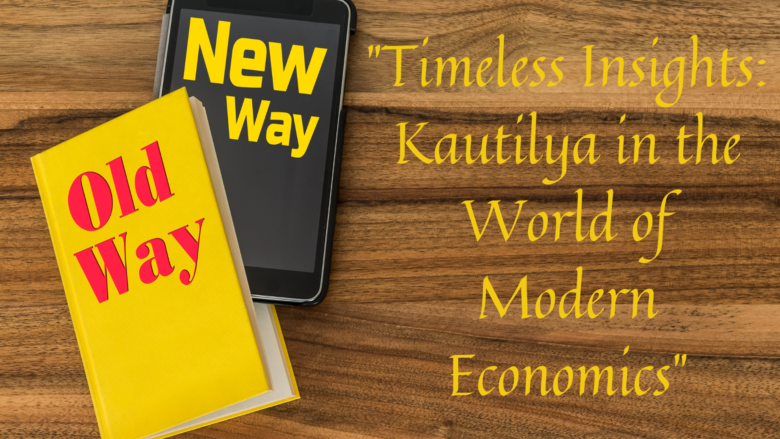In this three-part blog series, we will embark on a journey through time, comparing the ancient wisdom of Kautilya, an Indian philosopher, economist, and royal advisor, with contemporary economic thought. Today, we’ll explore how Kautilya’s teachings, primarily found in his treatise “Arthashastra,” align with or diverge from the ideologies of Joseph Stiglitz, Esther Duflo, and Stephanie Kelton.
Kautilya: The Master of Statecraft and Economics
Kautilya, also known as Chanakya, was the architect behind the rise of the Mauryan Empire in ancient India. His work, the Arthashastra, is a detailed manual on statecraft, economic policy, and military strategy. Kautilya’s approach to governance was holistic, intertwining economics with moral and ethical considerations. His principles of governance, law, diplomacy, and economic policy laid the foundations of one of the most prosperous empires of ancient India.
Joseph Stiglitz: The Voice of Equity and Redistribution
Joseph E. Stiglitz, a Nobel laureate, is renowned for his critical stance on globalization and his advocacy for income redistribution. Stiglitz’s work emphasizes the role of government in correcting market failures and ensuring equitable wealth distribution.
Comparing Perspectives:
- Market and State: Both Kautilya and Stiglitz recognize the state’s role in regulating the market. However, while Stiglitz focuses on market failures and income inequality, Kautilya’s Arthashastra suggests a more interventionist approach, with the state actively participating in economic activities.
- Ethical Governance: Like Kautilya, Stiglitz underlines the importance of ethics in governance. Kautilya’s insistence on moral and ethical governance mirrors Stiglitz’s concern for social justice in economic policies.
Esther Duflo: The Architect of Development Economics
Esther Duflo, a pioneer in development economics, emphasizes empirical research to address poverty and economic inequalities. Her approach is grounded in microeconomic realities, focusing on small-scale interventions for poverty alleviation.
Comparing Perspectives:
- Welfare State: Kautilya and Duflo share a common vision of a welfare state. Kautilya’s emphasis on the ruler’s duty towards the welfare of his subjects aligns with Duflo’s focus on poverty reduction and social welfare.
- Economic Intervention: Similar to Duflo’s advocacy for targeted interventions, Kautilya’s Arthashastra also recommends state intervention in various aspects of the economy and society for overall prosperity.
Stephanie Kelton and Modern Monetary Theory (MMT)
Stephanie Kelton is known for her advocacy of Modern Monetary Theory, which challenges conventional views about fiscal policy, government spending, and debt.
Comparing Perspectives:
- Fiscal Policy: Kelton’s MMT, which advocates for government spending as a tool for economic stability and full employment, finds an unlikely precursor in Kautilya. His proactive approach to economic planning and budgeting, especially the use of state treasury for societal welfare, echoes some MMT principles.
- Resource Allocation: Both Kelton and Kautilya understand the importance of prudent resource allocation and fiscal discipline for the long-term stability and growth of an economy.
Conclusion
This exploration reveals that Kautilya’s ancient wisdom, though from a different era and context shares surprising commonalities with modern economic thought. His comprehensive view of statecraft and economics, emphasizing ethical governance, welfare, and proactive fiscal policy, resonates with the works of Stiglitz, Duflo, and Kelton. In the next part of our series, we will continue this intriguing comparison with other prominent economists, further unveiling the timelessness and relevance of Kautilya’s economic philosophy.
Stay tuned for the next installment, where we delve into the economic philosophies of Milton Friedman, Amartya Sen, and John Maynard Keynes, juxtaposed against the backdrop of Kautilya’s enduring wisdom.
Author’s Note: The perspectives shared in this blog are based on interpretations and comparisons of economic philosophies across different eras. The aim is to provide a thought-provoking analysis rather than a definitive historical account. For a deeper understanding, readers are encouraged to explore the original texts and literature on these economists.
Join us in our next blog to explore more about the intersection of ancient wisdom and modern economic thought. Your thoughts and discussions are highly appreciated. Share your comments below or reach out to us at contact@ecosociosphere.in.
Note: This blog is a part of a three-part series. Click here to read the second part.
About the Author: G. C., a keen observer of economic theories, blends historical wisdom with contemporary insights, offering a unique perspective on global economic paradigms.
References:
- “Arthashastra” by Kautilya.
- “Globalization and Its Discontents” by Joseph E. Stiglitz.
- “Poor Economics” by Esther Duflo.
- “The Deficit Myth” by Stephanie Kelton.
- Various academic and historical sources on Kautilya’s economic principles.
© EcoSociosphere. All rights reserved. No part of this publication may be reproduced, distributed, or transmitted in any form or by any means, including photocopying, recording, or other electronic or mechanical methods, without the prior written permission of the publisher.
Connect with Us:
EcoSociosphere – In the Heart of Finance, In Tune with Society.





Comments
Most of अन्सिएंट economist emphasis parity in economic growth of all the section of society. In the case of koutilaya theory he solely emphasis ruler role in the economy.
Can you be more specific about the content of your enticle? After reading it, I still have some doubts. Hope you can help me. https://accounts.binance.com/de-CH/register?ref=UM6SMJM3